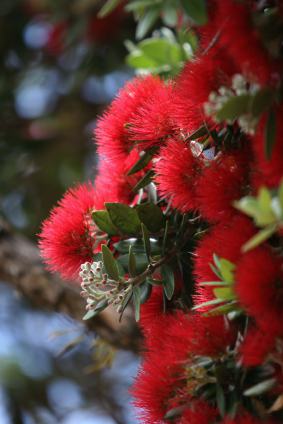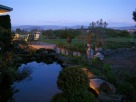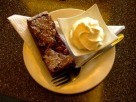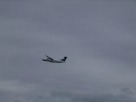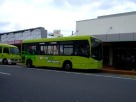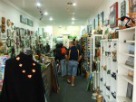One thing that almost no one outside of Rotorua would know is the amount of cultural history inlaid right into the design.1
- Home
- See & Do For Free
- Rotorua Lakefront
Rotorua Lakefront Visitors Guide
Looking for something a bit different on your next getaway? Try Rotorua Lakefront, packed with fun, relaxation, and culture—it’s all here!
If you want to feel more chilled out, a stroll along the boardwalk or among the native gardens will do that. If culture is of interest, the surroundings are full of it. If youngsters have anything to say, well, fun is their top priority. I guess the playground is a must.
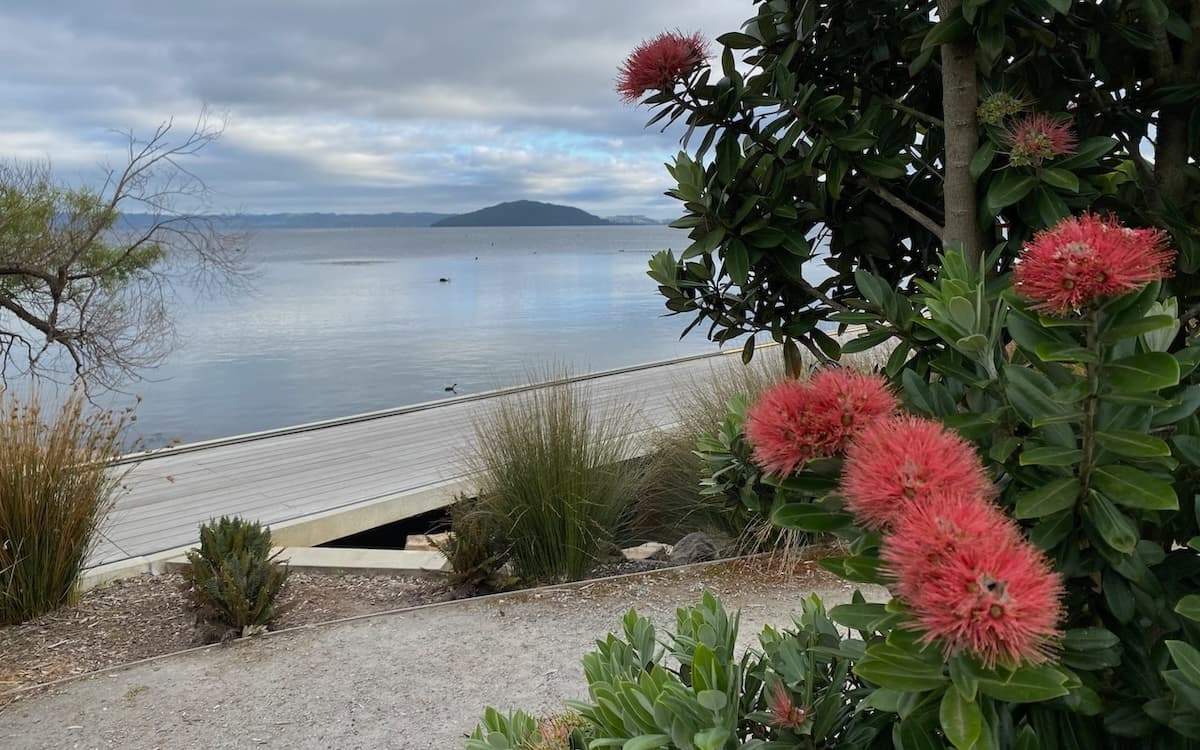 Eastern side of the boardwalk with a view to Mokoia Island. The flowers are Pohutukawa.
Eastern side of the boardwalk with a view to Mokoia Island. The flowers are Pohutukawa.Whether it's getting a jump start on the day, having a picnic under a shady tree, or zooming off on a wild water ride, there's something for everyone to enjoy.
Let me show you around. There's lots to cover. If you're in a hurry, check out the index below and jump down the page.
This Page Covers
Orientation
Basically, the lakefront is laid out in 3 sections. Using a google map, find the way to Whakaue Street. The view from there is:
- Centre stage is the Village Green grassed area. Concerts, carnivals, markets, events, and other activities take place there. Behind that is the playground followed by the lakefront itself.
- To the right of the playground are toilets and parking at Memorial Plaza. Further to the right is an empty block which was the site of QE Health - now demolished. Next to that block is Wai Ariki Spa & Wellness. Behind the spa is the ultra modern QE Health (health and wellness centre).
- To the left of the playground are more toilets. Behind is a display whare (house) of Te Arawa's Waka Taua (war canoe). It is used in cultural events and is regarded as a taonga (treasure).
Further to the left is more parking including camper van overnight parking, and the Rotorua Yacht Club. You’ll often see yachties, rowers, and waka taking to the water in this area. Tour businesses are located closer to the lake.
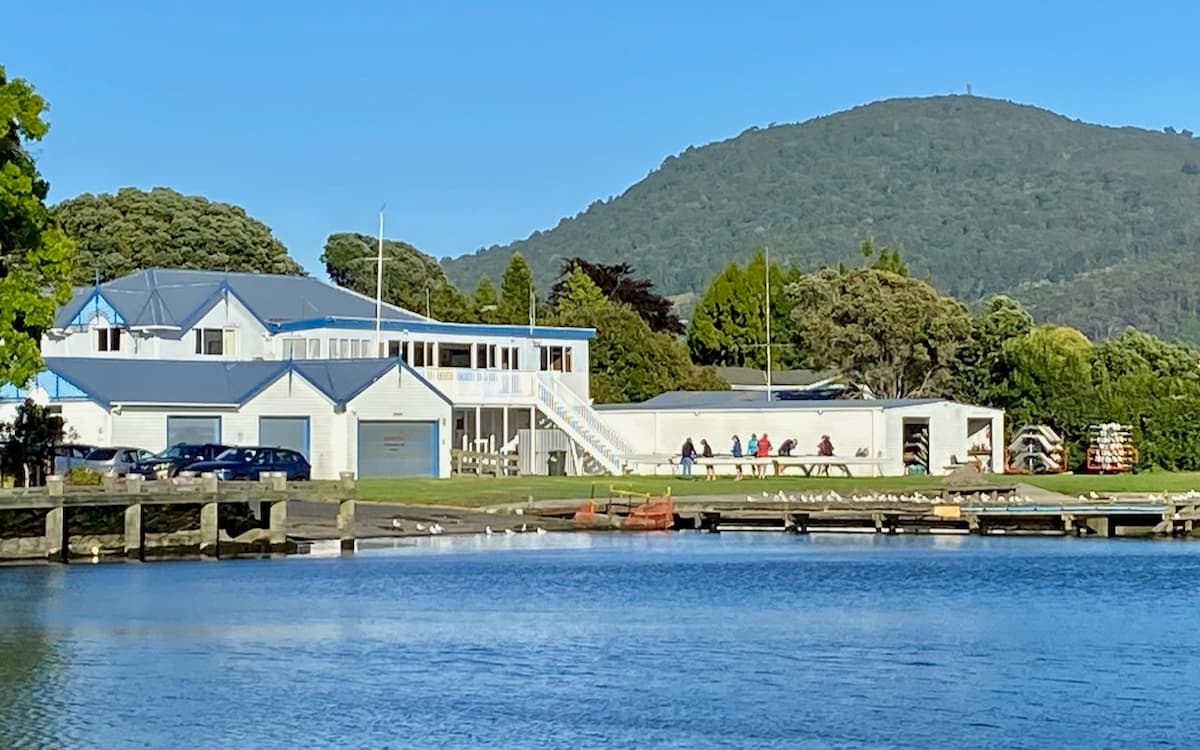 Rowers getting the boat ready to go out.
Rowers getting the boat ready to go out.A highlight of the lakefront is the wide boardwalk and terraced landscaping with native trees and shrubbery. Unusual pathways and bridges made of various materials go off in all directions.
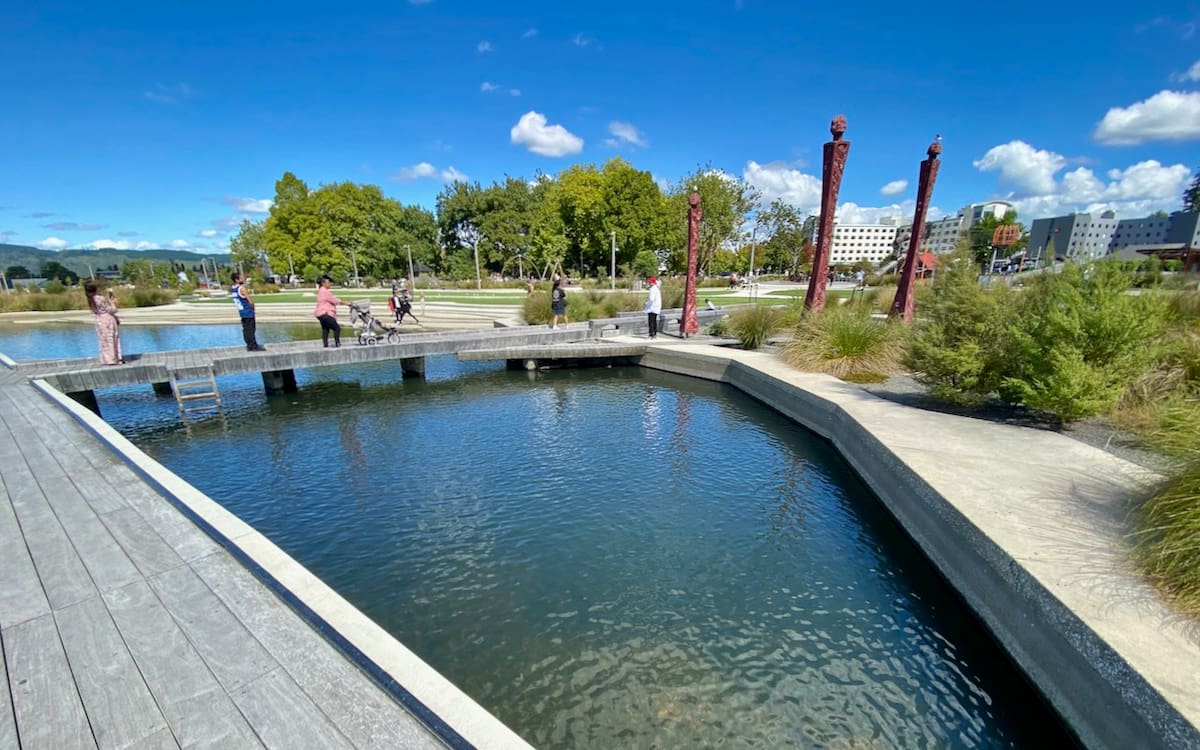 People out enjoying the lakeside grounds on a hot, sunny Rotorua afternoon.
People out enjoying the lakeside grounds on a hot, sunny Rotorua afternoon.Also planted in the gardens are three sets of tall pou (sculptures). The materials that each set is made of represents the past (wood), contemporary times (aluminium) and future (stainless steel).
Things To See & Do At The Lakefront
Fun at the Rotorua Lakefront Playground
Looking for a fun-filled family getaway? Find out how the child-friendly activities at Rotorua Lakefront can keep your family entertained. From what I've seen, adults aren't above this either. :)
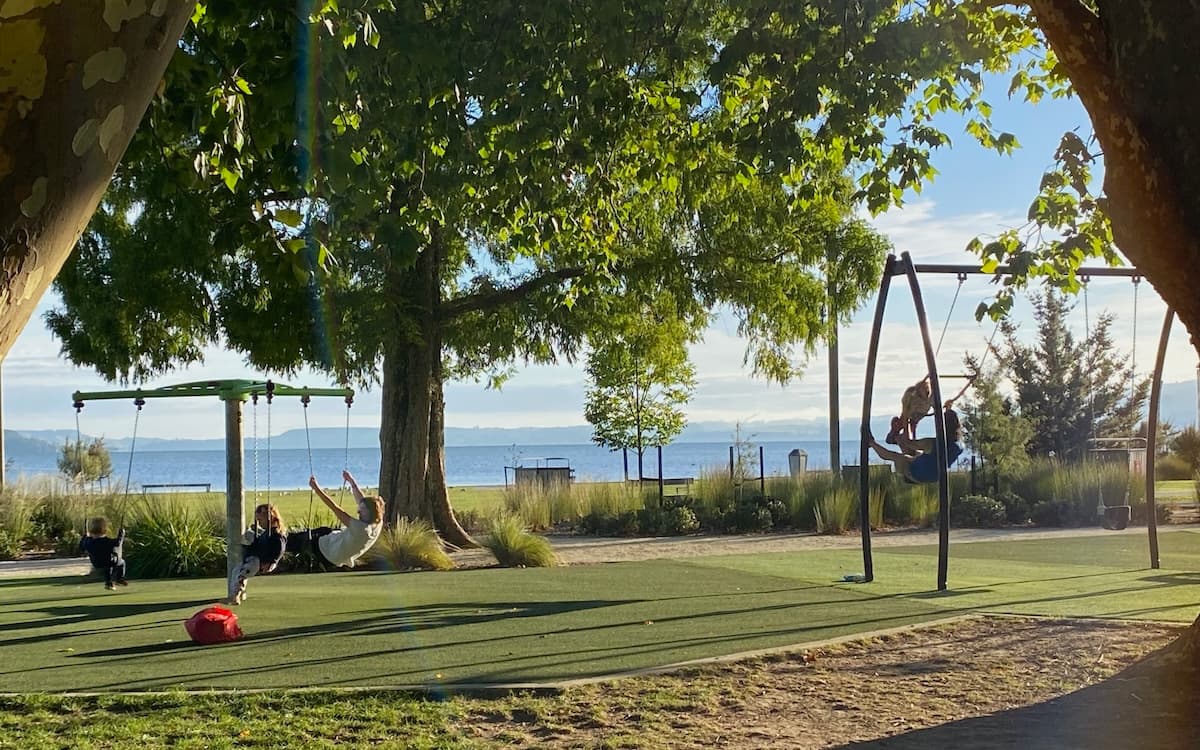 Parents enjoying the swings with their young ones at Rotorua's lakeside playground.
Parents enjoying the swings with their young ones at Rotorua's lakeside playground.Kids have a ton of fun at the playground. Who doesn't like to fly, swing, climb, dig, spin and slide? Flying foxes, a pendulum swing, and a net see-saw are a few examples.
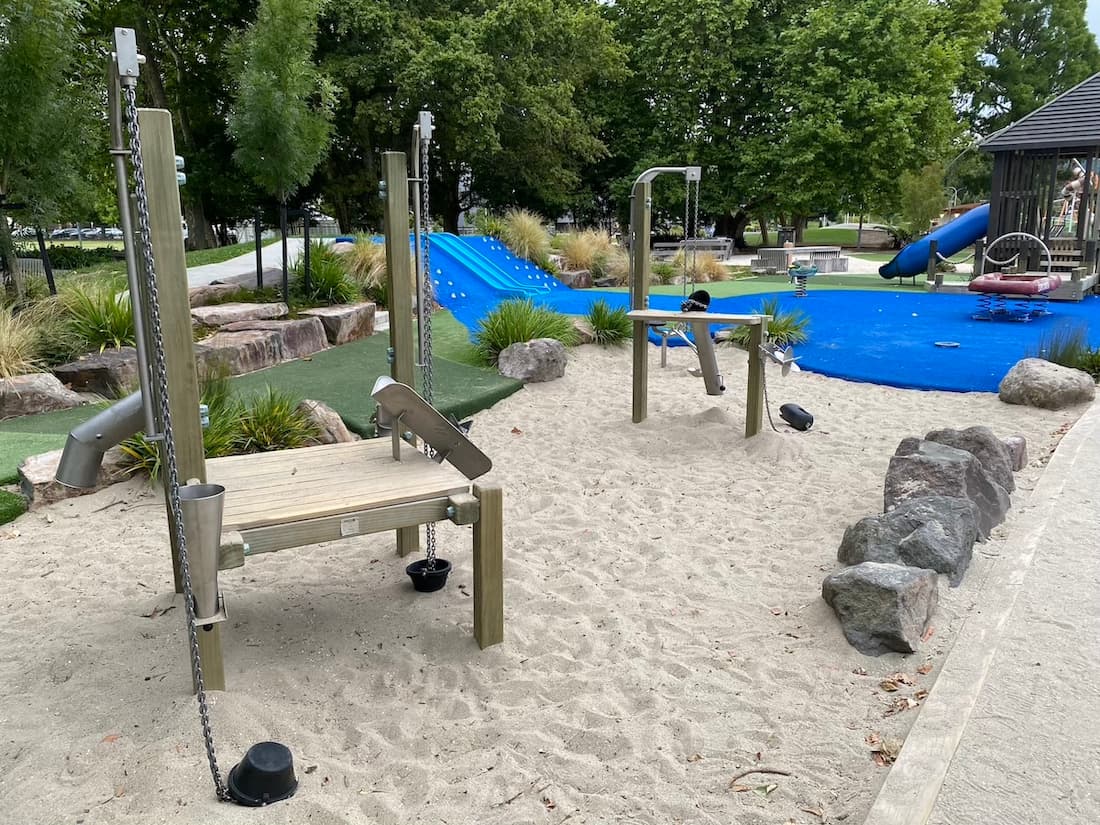 Kids love playing with buckets and shovels in the sandpit. Slides always go down well too.
Kids love playing with buckets and shovels in the sandpit. Slides always go down well too.Something else younger kids and teens like are the ride-on circuits. Trainer bikes, scooters, skates, bmx bikes, and any other wheel-based gizmo's can be used.
Tip: Climb to the highest point of the circuit to take photos.
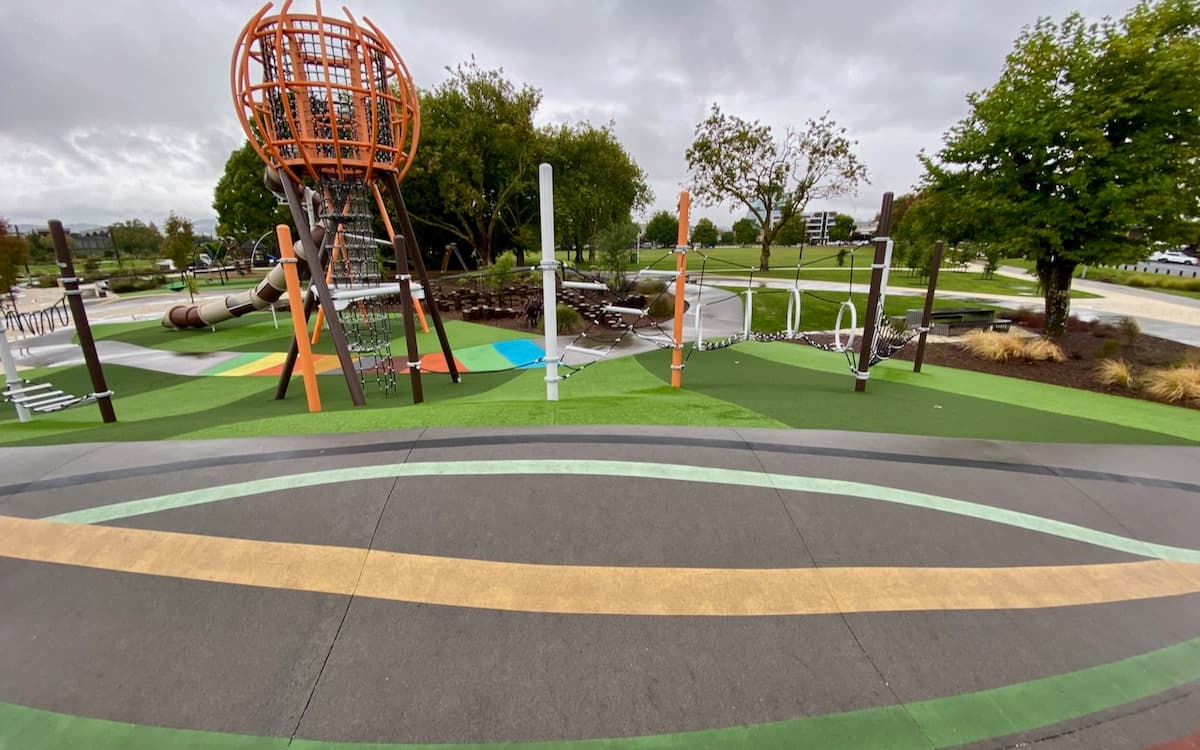 To the bottom of the photo is the highest part of the ride-on circuits.
To the bottom of the photo is the highest part of the ride-on circuits.On the other side of the circuit, teens are loving the half-court basketball for a bit of 1-on-1.
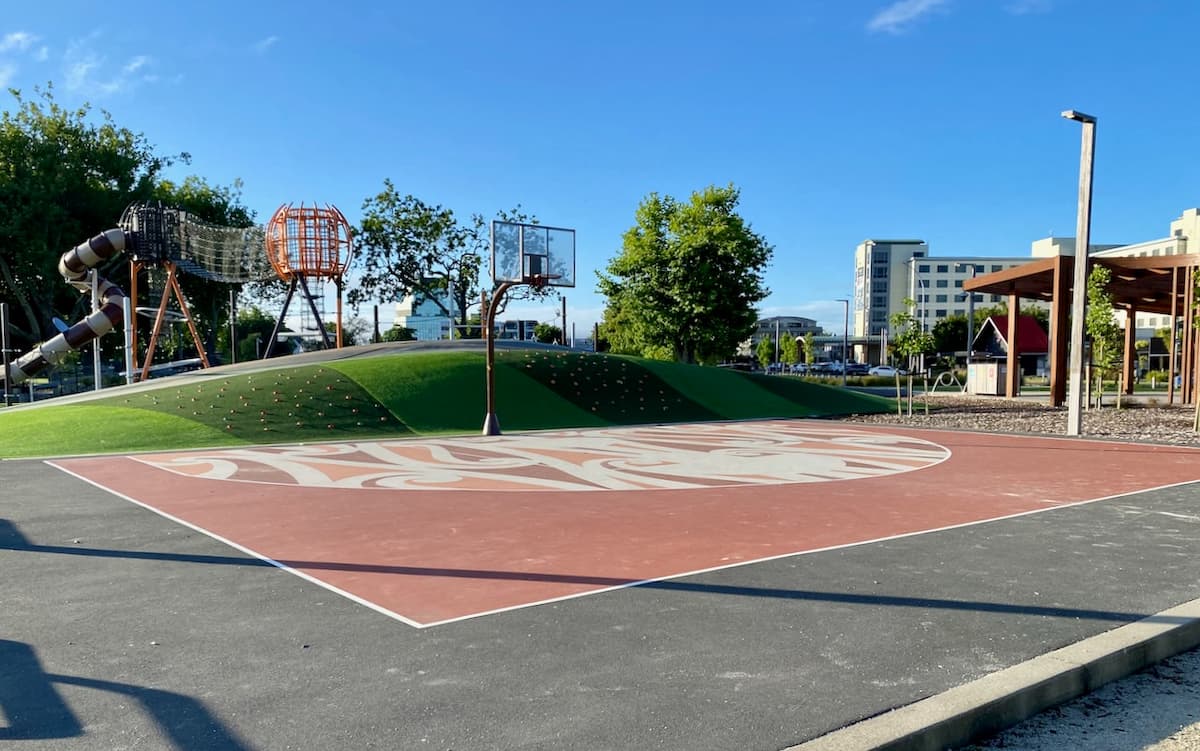 ½ court basketball area.
½ court basketball area.You’ll be hard-pressed to keep up with the kids bouncing from activity to activity. If recovery time is needed, plenty of seating is available.
Barbeques, located right by the playground, are something else to aid in recovery. It might make the kids sit down for 5 minutes to eat what's been prepared. Large older trees shade this area which is refreshing on a hot day.
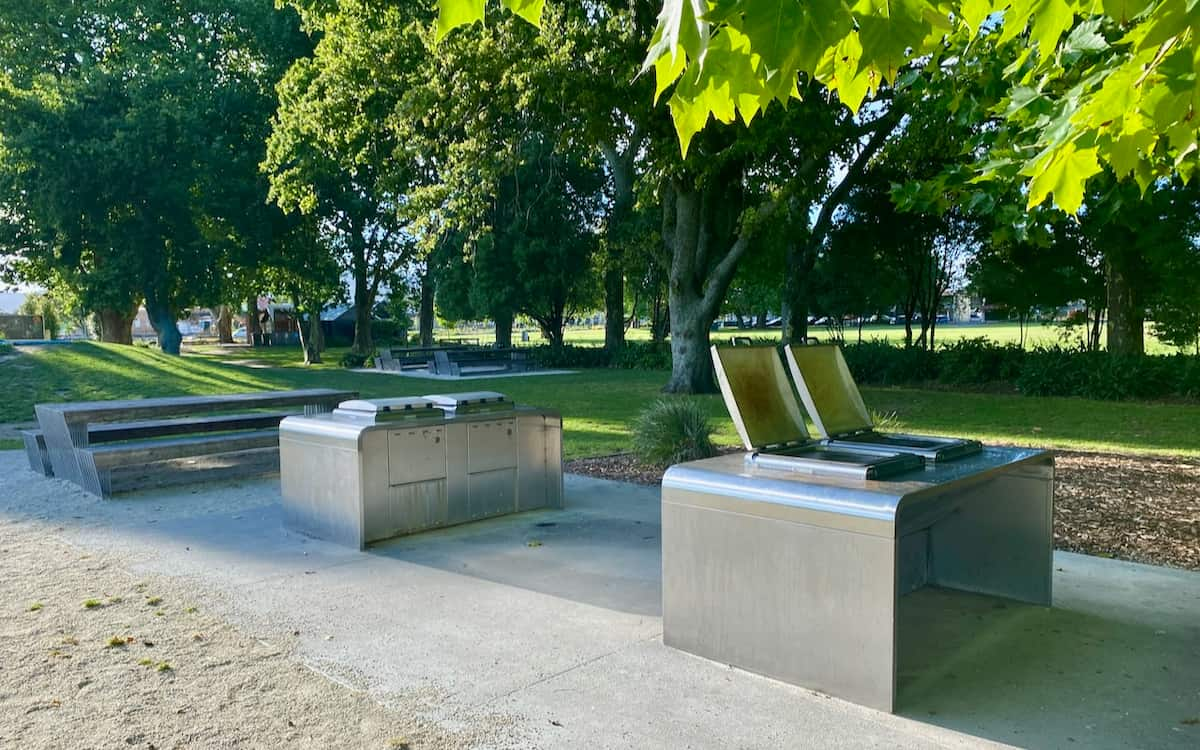 Barbeques at the lakefront with tables and seating nearby.
Barbeques at the lakefront with tables and seating nearby.Water fountains are plentiful. They can be found scattered around.
On the subject of the playground, guess what I saw early one Sunday morning? There were a few dads playing with toddlers. It's so cute to see. I guess the mums needed a good night's sleep. Dads can also be seen running or walking in the Redwoods forest, piggybacking a little one, or pushing a pram. It must be their time.
Unique Cultural Scenery
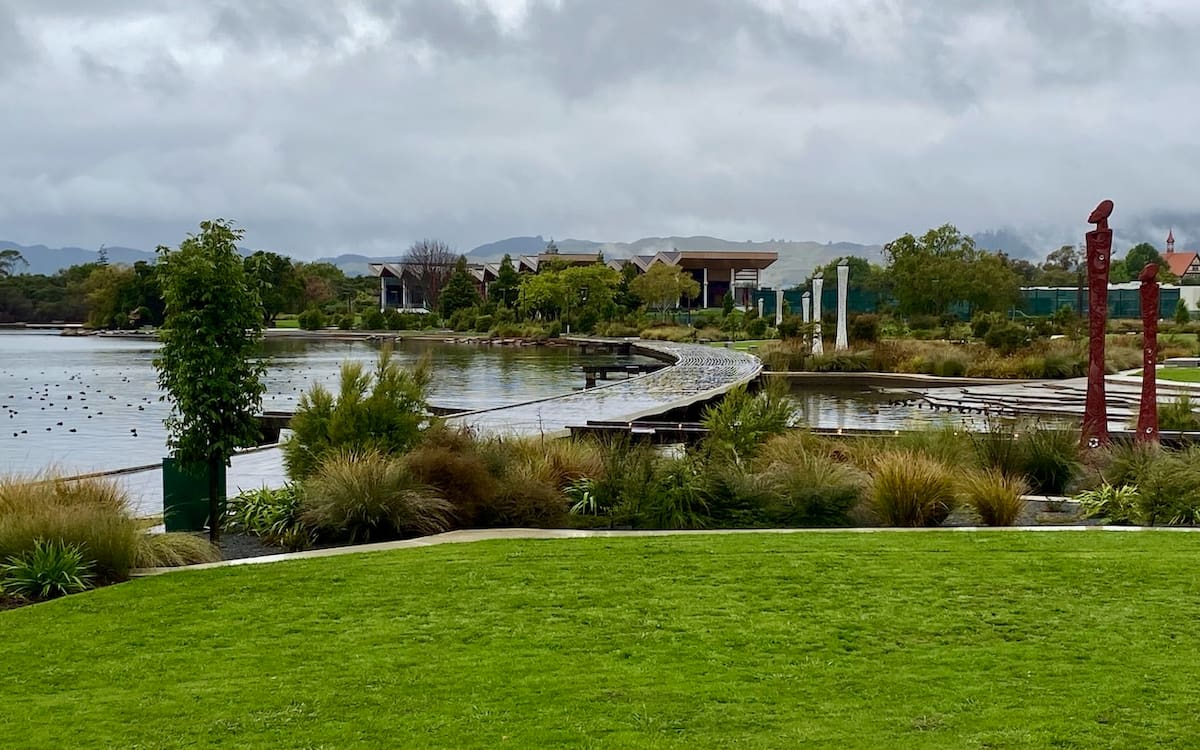 Lakeside view includes the boardwalk, terraces, landscape, and Wai Ariki Spa, on a squally Rotorua day.
Lakeside view includes the boardwalk, terraces, landscape, and Wai Ariki Spa, on a squally Rotorua day.Inlaid throughout the boardwalk, basketball court, contemplation bench, and sculptures are local Māori designs telling stories of local history.
The way the land has been connected to the water in different ways is reflective of what's in the lake, the area, and the history of the people.
Use of native tree and shrub species found in the gardens instead of the colonial gardens of old. Mind you, I think that's a trend that has taken off nationwide. Nothing compares to using what has withstood the test of time in this often harsh environment, and is beautiful.
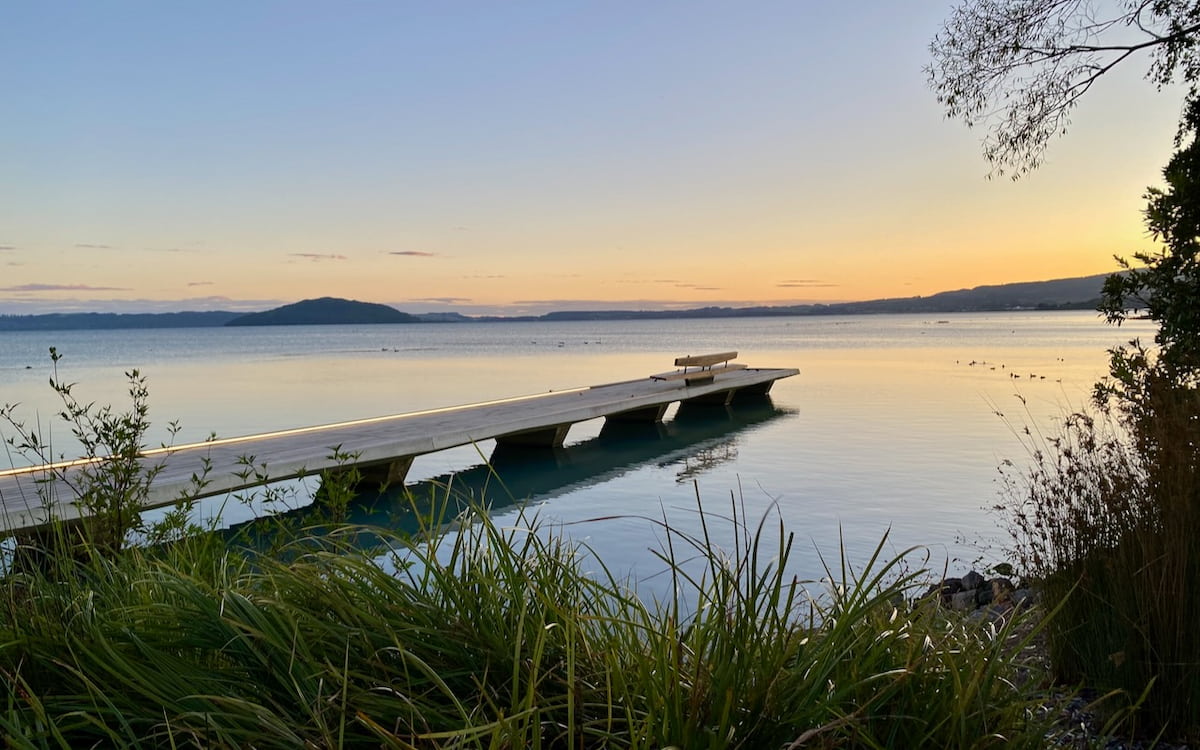 Sunrise at the eastern end of the boardwalk with a seat for contemplation and reflection (Te Toka Māpuna) looking towards Mokoia Island.
Sunrise at the eastern end of the boardwalk with a seat for contemplation and reflection (Te Toka Māpuna) looking towards Mokoia Island.Sidenote: Having a connection to the earth, the lake, the sky, and other people makes life feel better. This is how being by the lake feels to me.
Waterfront Tours
Katoa Jet: Looking for some of the best kind of fun? Having been out on this jet boat ride a couple of times, fun is what's delivered. Speed bouncing over the water and 360° turns tend to wow most people.
As well, the drivers have a knack for bringing the history of the lake area and the stories of the people alive.
Unless motion-sickness is on the table, this is a must do. Kids, teens, and adults love these rides!
Book Katoa Lake Rotorua Jet Boat Tour 30min
Book Katoa Jet Boat & Lake Rotoiti Hot Pools Tour 2½ hrs - This tour has the added benefit of a thermal hot pool soak, with a choice of 6 pools.
Hours: 9am - 4:30pm daily
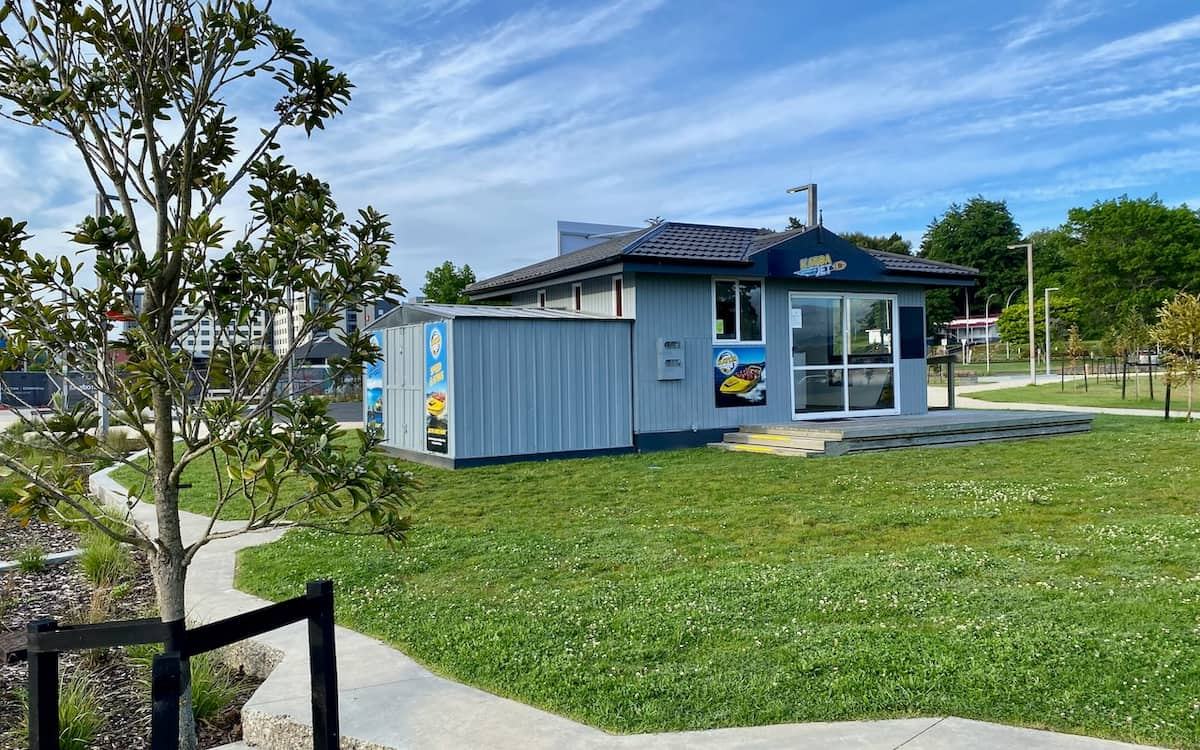 Katoa Jet Boats booking location.
Katoa Jet Boats booking location.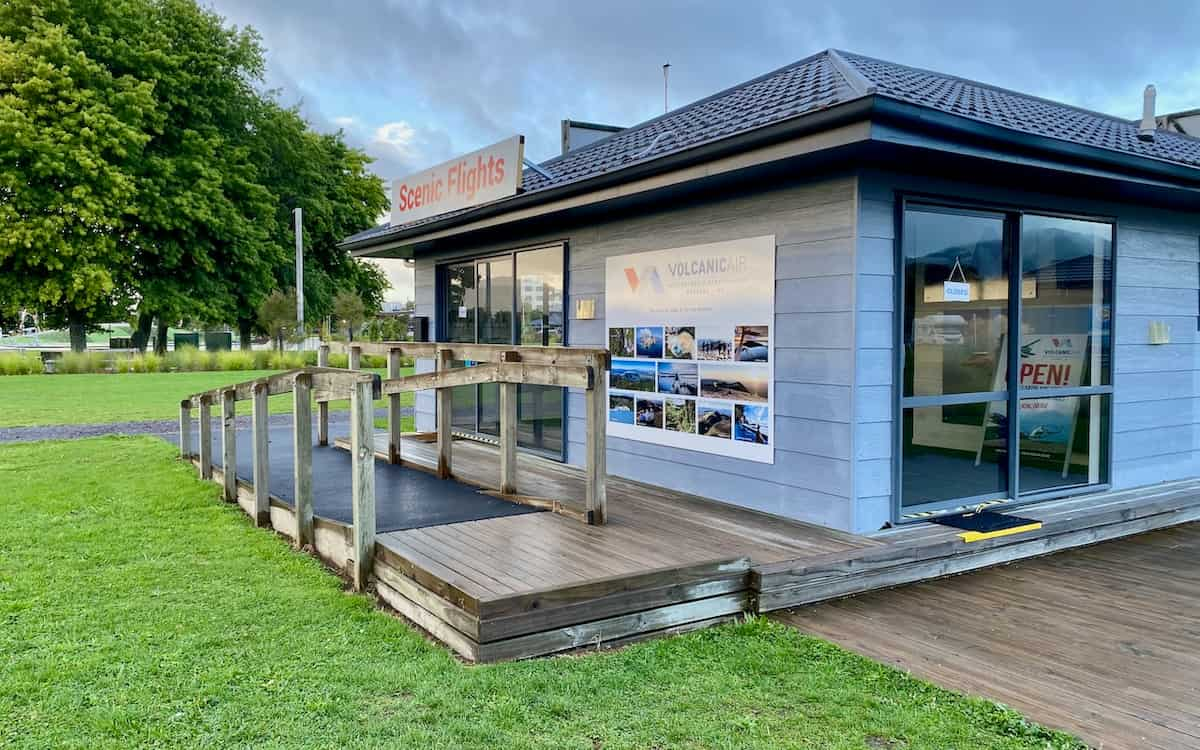 Volcanic Air scenic flights location.
Volcanic Air scenic flights location.Volcanic Air: Take to the skies on a float plane with Volcanic Air. This cool tour is a 40-minute (30-minute flying) scenic flight featuring eye-catching views of Lake Rotorua and Mokoia Island before flying to the hidden lakes area.
I hope you've got a head for heights as the plane soars up and over Mount Tarawera. It last erupted in 1866, and stands at 3680 feet above sea level. From there, Waimangu Volcanic Valley offers aerial views of Inferno Crater and Frying Pan Lake before heading back home over the Whakarewarewa Thermal Valley.
Book Scenic Flight Over Mt Tarawera & Waimangu Valley
Hours: 8:30am - 5pm daily
10 Fun Facts About Lake Rotorua
- Rotorua is located in a caldera (basin) left after the last eruption, approx. 220,000 years ago. The hills you see around our city are the sides of the collapsed volcano.
- Dome-shaped vents emerged following the eruption. Those domes are Mokoia Island, Mount Ngongotaha, and Hospital Hill.
- Mokoia, a Wildlife Refuge, is home to endangered species such as Kiwi, Weka, Kōkako, saddleback and others. Local tribes and the New Zealand Department of Conservation jointly manage the island to ensure it remains predator-free.
- Recent evidence 2(2023) points to a large paleo river that flowed along the lakebed from Sulphur Point. Rounding to the left of Mokoia Island, the river veered off towards the north-west. The lake itself is said to have filled in about 65,000yrs ago.
- Since 1965 the 3Rotorua Red Stag Marathon (42.2km) has taken place annually on a winding scenic loop around the lake. That is, barring one, 1999. Torrential rain fell continuously in the 24-hour lead-up to the event. Parts of the road on the far side of the lake were washed out. This forced the race to be cancelled 5 minutes before the starting whistle.
- Lake Rotorua is prolific for Rainbow and Brown Trout Fishing. The local hatchery releases hundreds, if not thousands, every year. Licences can be bought online.
My brother Dean caught over 400 in the 2023/24 summer season because conditions were outstanding. As many avid anglers do, only a few were kept, and the rest were released.
Fun fact about him. He refuses to gut or eat trout and dislikes the slimy feel. Claims he's done his job by catching them. Brothers! - At Mourea, the Ohau Channel connects Lake Rotorua to Lake Rotoiti. The channel bridge at Mourea is where you'll cross if you're travelling on SH33 to Tauranga or Mount Maunganui.
The water is funnelled along the shoreline of Lake Rotoiti (to keep Rotoiti clean) into the Kaituna River and then out to sea. - Eight streams flow into the lake with some being natural springwaters. Hamurana and Awahou Streams are two of those.
- The lake is shallow until it’s not! You will often see sand strips at the lakefront. At other times when severe storms happen, the water level rises until waves break over the shore.
While in bed during a severe storm, I wondered whether I'd wake up to water lapping at my front door. Yikes. - Travelling around the lake by car takes less than an hour. Multiple spots provide incredible views and photo opportunities. The northern Hamurana side of the lake is one such area with various places to park up.
Located Nearby
Attractions Within Walking Distance
Tip: Every single one of the nearby attractions mentioned has some sort of thermal activity going on.
- If you walk in an easterly direction along the lakeside past Wai Ariki Spa the road takes you to the Government Gardens, Sulphur Point (both free) and Polynesian Spa. About a 15 minute walk will get you there. You can access the same by car via Arawa Street.
- At the rear of the Yacht Club a short 5 minute walk along Mataiawhea Street takes you to Ohinemutu. It’s another place people frequently want to wander through. Villagers will be going about their daily lives, and you may possibly see how they cook with thermal, or when they're off for a bath in the family bathhouses.
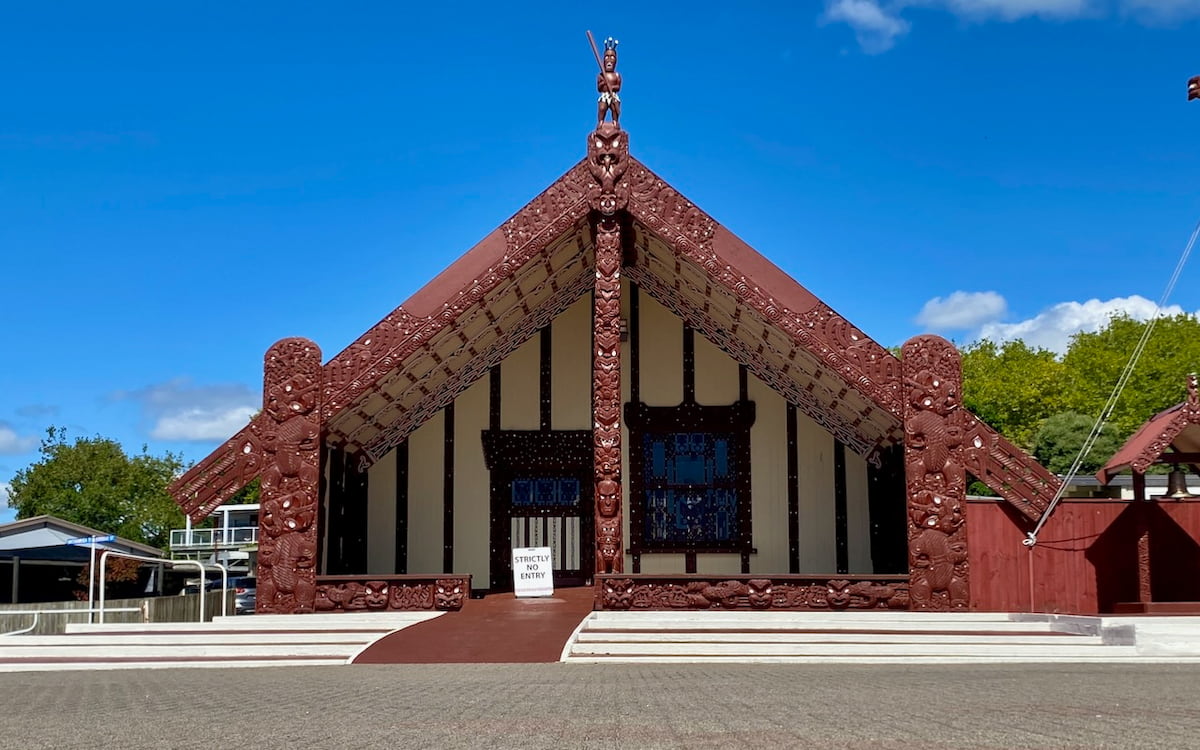 Tamatekapua Meeting House at Ohinemutu, is a short walk from the lakefront.
Tamatekapua Meeting House at Ohinemutu, is a short walk from the lakefront.- Kuirau Park is on the bucket list of most visitors, as a lot of thermal can be seen for free, plus it's lovely to wander through.
Make your way from the eastern side of the lakefront to the roundabout on Lake Road. Across the road is a hill, which you can walk up to the Rotorua Hospital. Carry on past it, over the hill, and down the other side. Kuirau Park is across the road at the bottom of the hill.
If you don't want to walk too much uphill, walk to the right along Lake Road until a set of traffic lights is reached. Cross the road to Kuirau Park. See pdf of the Rotorua Walkways.
The intricately carved Tamatekapua Meeting House is also located at Ohinemutu, as is St Faiths Church. St Faiths is a good example of the blending of both Māori and European cultures. It attracts a small cost to view.
Something everyone needs to know before visiting is to be respectful of the villagers and the village. This is their home after all.
Accommodation Options
There's a lot to be said for staying close to the lakefront. You can stroll over to enjoy the first or last moments of the day. As mentioned earlier it's a hub that draws in a lot of action be it with markets or events, etc., plus you're literally spoilt for choice when it comes to having so many eateries nearby.
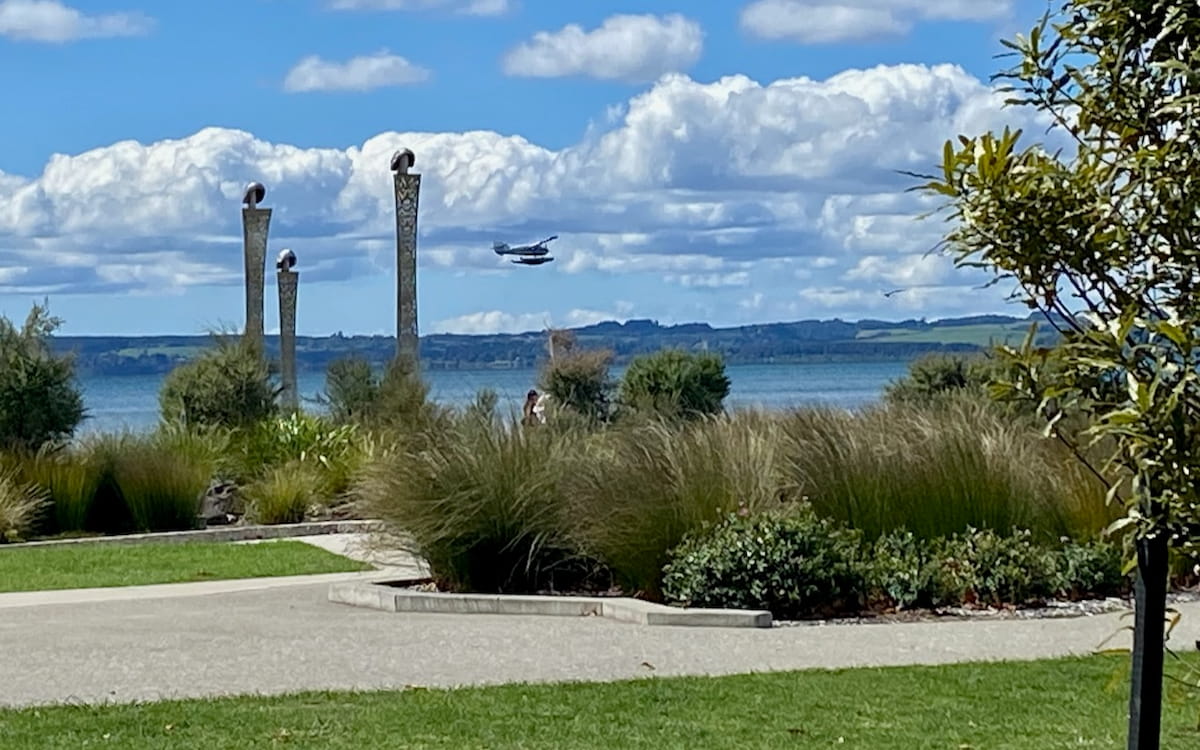 Lakefront Pou Tumu (sculptures) rise into the sky as a Volanic Air floatplane flys past.
Lakefront Pou Tumu (sculptures) rise into the sky as a Volanic Air floatplane flys past.You will find a good range of accommodation within the immediate vicinity. Here's some of my top picks:
Aura Accommodation: 3 star motel that has guest reviews giving it a 9/10 rating on Booking.com. Studios sleep from 3 - 6, also has 2 bedroom apartments. Kids can have a great time just staying on-site. Located on Whakaue Street it's a short walk to Eat Street. Free bikes/scooters available, private thermal pools, hot tub, swimming pool. Check prices and availability.
Lake Lodge Motel: 3 star lodging sleeping from 2-5 people. Tucked back off Lake Road it's likely you'll have lake views. A few minutes walk across the road will have you at the lakefront. This is the place for a romantic getaway. Free wifi and parking, tour desk, self-serve laundry. Check prices and availability.
Novotel Rotorua Lakeside Hotel: 4.5 star good-quality hotel overlooks the village green and lakefront. Atlas Restaurant has an international menu for breakfast, lunch and dinner. Views out over the lake from the higher floors are outstanding. Thermal pools and a pool, free wifi and parking, babysitting service. Check prices and learn more.
Ibis Rotorua Hotel: 3.5 star economy hotel for leisure and business. Also overlooks the Village Green. Shares some facilities (pools too) with next door sister hotel Novotel via a connecting corridor. Free and paid wifi, free parking, laundry service and self-service. Entrance is on Rangiuru Street. Check prices and availability
Dining Choices
It's envisioned that a restaurant and cafe/s will be sited in a commercial zone at the lakefront but I'm sorry to say, that's not yet.
What you will find are 2 kiosks selling ice cream, shakes, coffee, tea, and a small selection of cabinet food on the eastern side of the playground.
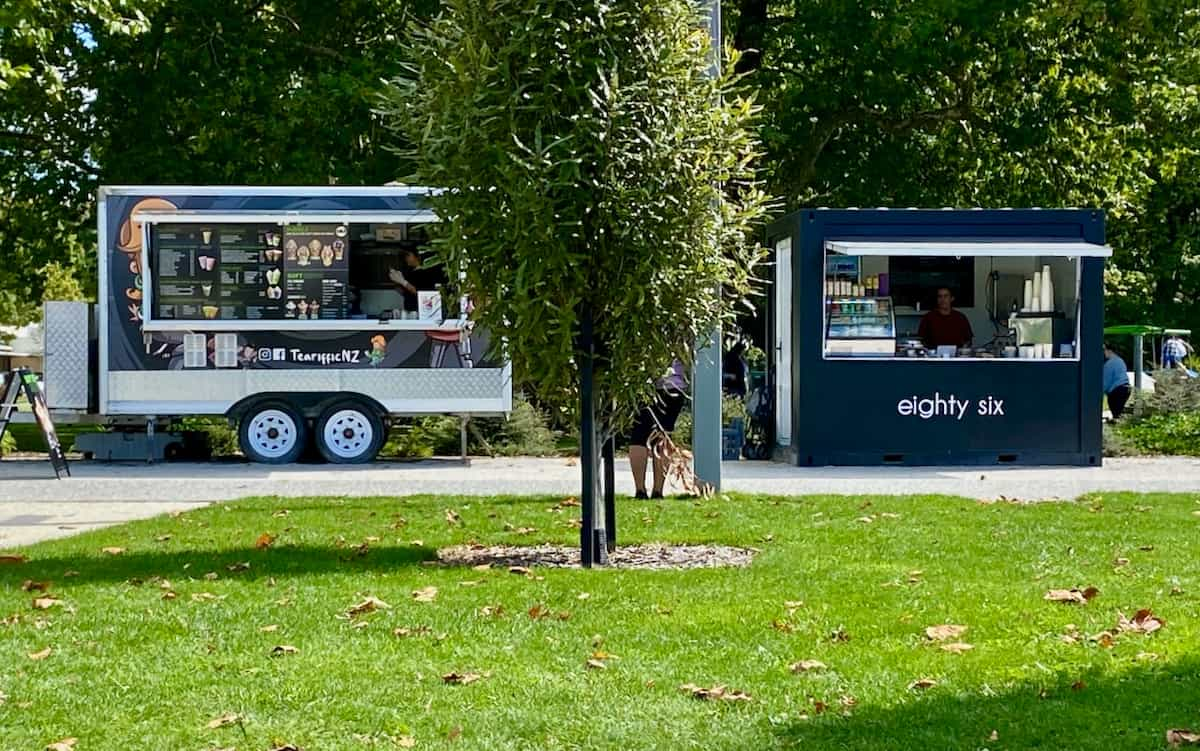 Kiosks TearifficNZ and Eighty-six are located east of the lakefront playground - Rotorua.
Kiosks TearifficNZ and Eighty-six are located east of the lakefront playground - Rotorua.On the intersection of Whakaue and Tutanekai Streets (bordering the village green) is Eat Streat. This is the undercover hub of much of Rotorua's dining with many popular family-friendly cafes and restaurants, all contained in one block.
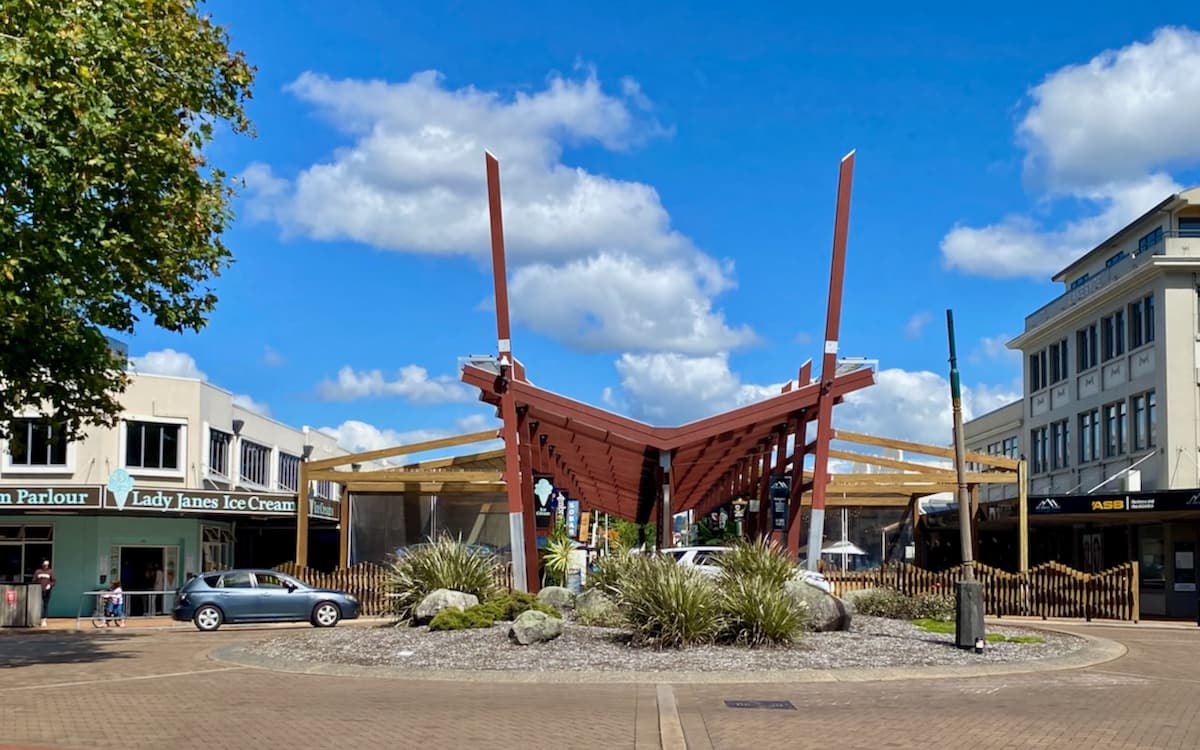 Northern entrance to Eat Streat - cnr Whakaue and Tutanekai Streets, opposite the Village Green.
Northern entrance to Eat Streat - cnr Whakaue and Tutanekai Streets, opposite the Village Green.It's where you will find the likes of Lady Jane's (pictured) for ice creams on those hot days, or craft beers at Brew Craft Beer & Pub when you want to cool down. There's Sobar, Indian Star, Atticus Finch, the list goes on.
Food places continue on past the undercover section of Eat Streat for another block, and round the corner into Arawa Street. El Mexicano Zabata Cantino, Fainting Goat, The Thai Restaurant, Subway and a fair number of others.
There's also a dairy on the corner of Tutanekai and Arawa Street.
Parking at the Lakefront
Two parking areas are available at the lakefront in addition to street parking on Whakaue & Tutanekai Streets, and Lake Road.
Western carpark, off Lake Road - Has a mixture of 79 free or time-limited parks (3 hours). 4 disability parks are included in this area too.
At the far end of all the parking is St Michael's Church (red brick building). Beside it three freedom camper parks are allocated for self-contained campervans at no cost - I've often seen quite a few more parked up in that area though. Showers, water, power, or a dump site are not provided. Toilets and water fountains are nearby.
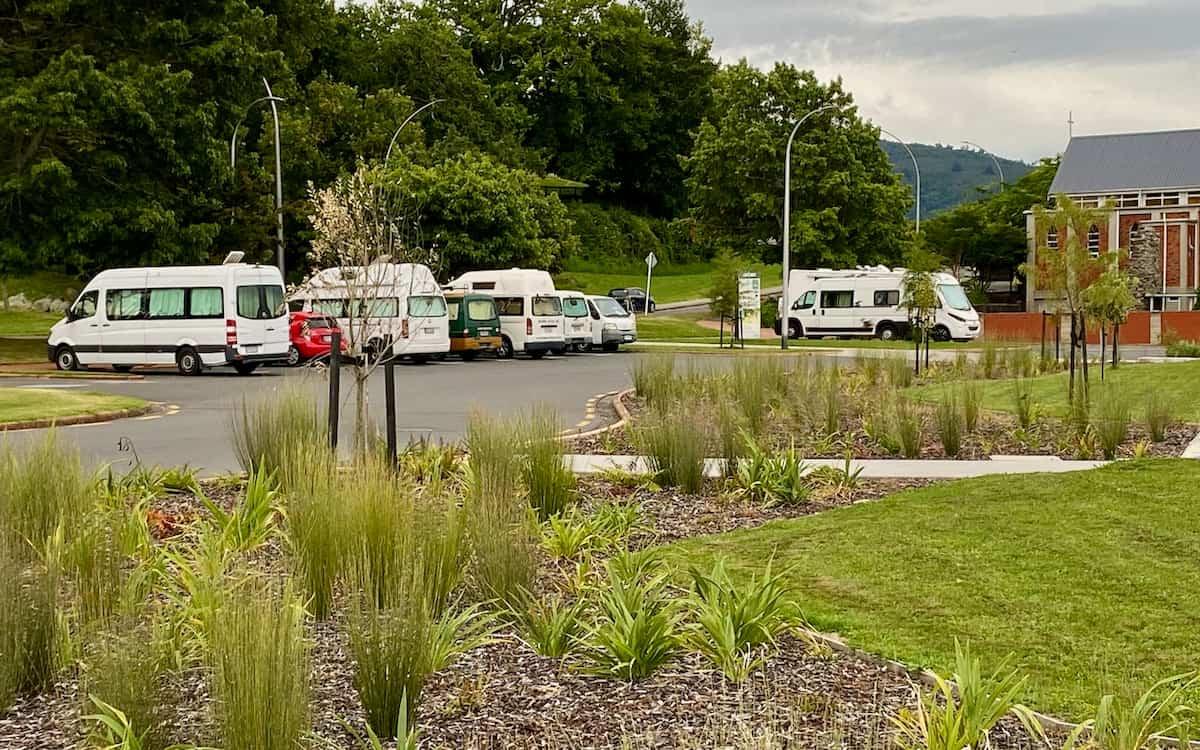 3 Freedom Camper parking bays are located on the right side of the image, next to St Michaels Church. As you can see, other campers have parked up too.
3 Freedom Camper parking bays are located on the right side of the image, next to St Michaels Church. As you can see, other campers have parked up too.Eastern carpark at Memorial Plaza, off Fenton Street - Includes 77 free parks. Disability parks are available as is parking for larger vehicles. Parking here is limited to 2 hours.
Street Parking - Mostly pay-to-use parking is found on Whakaue & Tutanekai Streets 9am-5pm Mon-Fri and 9am-12pm Sat. Lake Road has a good number of free 90min parks. Public holidays are free for all parking. You'll find some free 15min parks. Metered parking is enforced.
Accessibility Options For People With Disabilities
As mentioned previously, disability parking is available at the lakefront carparking areas.
The landscape is flat and pathways of concrete and timber allows for the ability to move between different areas with relative ease. The grassed Village Green is probably the hardest to push things like wheelchairs on, and maybe scoria on parts of the children's playground could be hard depending on the level of disability.
Both toilet blocks have disability toilets and easily accessible.
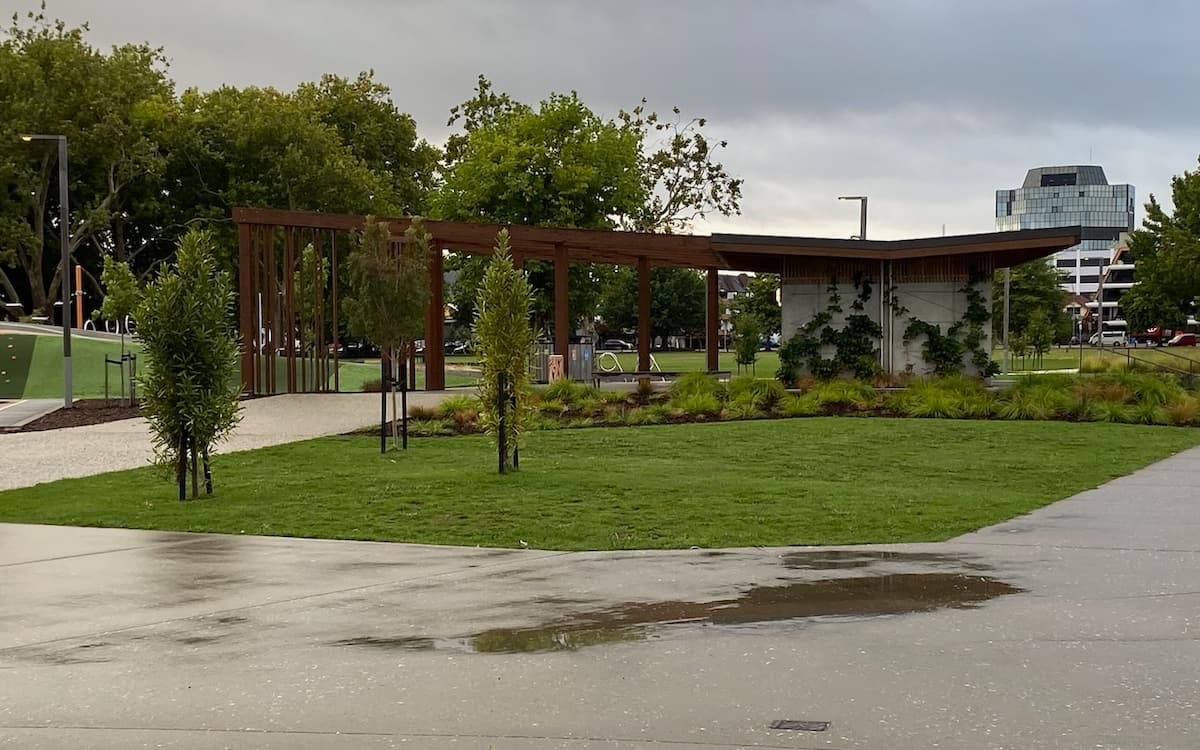 Western toilet block.
Western toilet block.Good to Know
- An enforceable liquor ban is in place within the (CBD) Central Business District. It prohibits the consumption of alcohol unless there is a special licence or in places that have al fresco dining.
- Trout flies can drive you mad at the lakefront sometimes. Swarms of them appear, mainly early morning or dusk.
'Keep Your Mouth Shut', or they'll end up stuck down the back of your throat. One good thing, they don't have mouths.
Best thing I've found is to have a cap on and lower your head when you see a swarm heading your way. - Lakeweed is quite a problem at times along with algae bloom. When we have big storms and strong winds the lakeweed is driven into shore, even onto the pathways at times when the lake level is high. What gets left behind is an unsightly stinking mess, rotten stinking, which is made worse when temperatures are high.
- Birds poo everywhere! Mainly seagulls, swans and geese. So, if you're out and about early, before the council cleaners, chances are high that you'll strike this. Keep your eyes peeled. View or poo, view or poo.
- Lowlifes tend to make their way to the lakefront at times. Creating trouble is what they do. If you see anything, contact the Safe City team. Rotorua Lakes Council takes calls by a 24 hour phone number 07 348 4199. Email is another option: info@rotorualc.nz.
Best Time of Year & Day to Visit
Any time of the year is fine to visit the lakefront. High season for visitors is Dec-Feb, our Summer season. Temperatures rarely reach let alone exceed 30℃ (86℉). It may be frosty in winter (Jun-Aug) but that's usually about the extent of any extremes.
Weather and What to Wear - As this is a water-side location it can be quite windy at times. I recommend early mornings and evenings as a nice time to visit the lakefront. Often the wind has calmed down around those times. Dawns and sunsets can make for stunning photo opportunities.
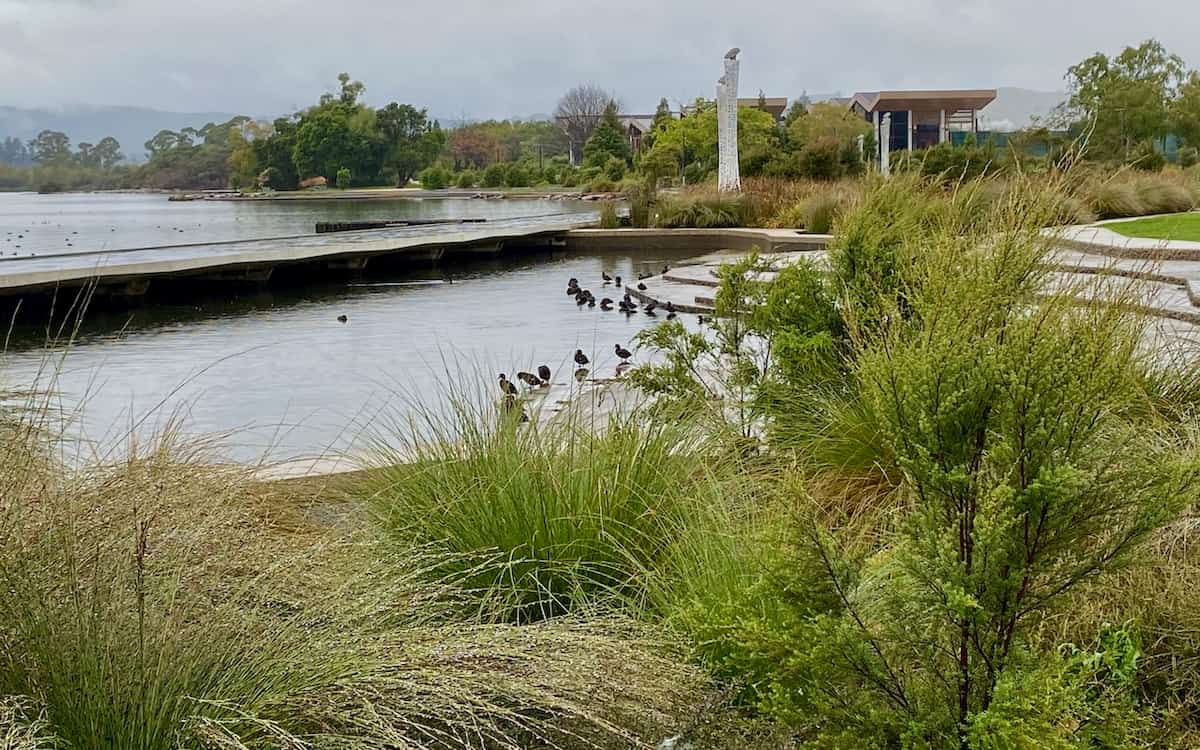 A day best suited for ducks
A day best suited for ducksClothing-wise it's always best to have layers available wherever you are in Rotorua. You can't make a call on the weather as it's so unpredictable. We may have boiling hot days but early mornings and evenings can be extremely chilly. Icicle chilly! Even in summer!!!
Check out my page Rotorua Weather for further information.
How to Get to Rotorua Lakefront
Public Transport - The closest you will get to the lakefront by bus is a central hub on Arawa Street, around the corner from I-site Visitor Information Centre. From here it's about a 5 min walk in a northerly direction to the lakefront via Fenton Street, or Tutanekai Street. Use the following Journey Planner at Baybus - Google. Input your start/end point and it will do the rest.
Driving - Whichever direction you come into Rotorua's CBD, find your way to Whakaue Street using Google Maps and refer to the earlier parking information. Google hasn't updated the map yet and still displays the previous roading at the lakefront. The only 2 roads you can drive right to the lakefront area are Fenton Street and Lake Road.
A Brief History of The Lakefront Area
Originally, the lakefront area was a landing site for waka (canoes) of Ngāti Whakaue people who lived at various sites - what we now call suburbs - dotted around the lake.4
As much of the lakefront area was gifted by the iwi (tribe) to Rotorua city things changed over time.
Reclamation work took place in the 1930s to extend the lakefront further out into the lake.
Tourism began to grow which was encouraged and with that came the desire to better the lakefront. A playground evolved, water-based activities, entertainment and annual carnivals became the norm in the 1900s.
This latest change has brought with it a blending of the history built right into the design.
Lakefront Redevelopment
Since undergoing a major redevelopment, our lakefront has become something to be proud of, a place we happily recommend to our visitors, and a place we want to frequently make use of ourselves. That says a lot, doesn’t it?
It’s taken a collaborative approach by so many both within the community and outside of it to have this grand design come together.
Isthmus Group5 are the designers hired by Rotorua Lakes Council to come up with the master plan.
Isthmus collaborated with local iwi Ngāti Whakaue, Te Arawa Lakes Trust, Karl Johnstone of Haumai NZ - the cultural design coordinator, and local master carver and sculptor Lyonel Grant who was involved, together with Ngāti Whakaue, in all aspects of 5Mahi Toi (artwork).
Even the opinions of local children were taken into account for the playground design, and wow, what a design it is.
Now we have a lakefront that is, to put it simply, World-Class.
Frequently Asked Questions
What are the costs associated with visiting Rotorua Lakefront?
What are the costs associated with visiting Rotorua Lakefront?
Answer: It's free to visit Rotorua Lakefront. Any costs would be related to the purchase of food or tours. It would also be free to enter markets and carnivals. Private events held on the village green have their own associated costs. Usually, these are fenced off if paid entry is required.
Can you swim in Lake Rotorua?
Can you swim in Lake Rotorua?
Good question. Personally, I wouldn't. Most locals don't consider it a swimming lake. What a shame, huh? We head out of town to other lakes. The Blue Lake (cold) is a big favourite, as is Lake Tarawera (warmer).
Over time, a lot of nitrogen and phosphorus have seeped into the lake.The thermal fields, runoff from forestry and farms, and lag times are largely responsible. By depriving the lake of oxygen, harmful algae bloom growth conditions are created. Work is underway to restore the balance, but it's a long-term process.
How much did the Rotorua Lakefront cost?
How much did the Rotorua Lakefront cost?
By all reports I've seen, the cost stands at around $40,000,000. It took a lot of hard work by multiple parties and community engagement to get the lakefront development to where it is today. World Class!
How deep is Lake Rotorua?
How deep is Lake Rotorua?
Lake Rotorua is referred to as a shallow lake, with depths recorded as 20-25m.
The recent 2023 Lake Rotorua survey by GNS Science recorded "... a 2-meter grid of bathymetric data, reaching a maximum depth of 53.5 meters off Sulphur Point".
Why is Rotorua called the second lake?
Why is Rotorua called the second lake?
Explorer Ihenga named many places in the Lakes District. He discovered and named Lake Rotoiti (in short, the little lake) prior to Lake Rotorua. The full name of Lake Rotorua is Te Rotorua nui-ā-Kahumatamomoe. Meaning: Roto-lake, rua-2 or second, nui-large, Kahumatamomoe—name of Ihenga's father-in-law.
References for Further Reading
If, like me, you are curious and like backstories, you may enjoy this section.
Five of the best web pages to learn more about our lakefront history, how the design for the redevelopment transpired, meaning behind some of the cultural designs, lakebed revelations, and our marathon history are as follows:
- Isthmus - Meaning of cultural designs: https://isthmus.co.nz/rotorua-lakefront-mahi-toi/
- New Maps of Rotorua Lakebed https://www.gns.cri.nz/news/new-maps-reveal-lake-rotoruas-hidden-depths/
- Rotorua Red Stag Marathon History https://www.rotoruamarathon.co.nz/about/history
- Rotorua Lakefront History: Sorry, the following referenced page has disappeared. https://visiontoaction.nz/projects-home/lakefront-development/the-history-te-tahuhu-korero/
- Isthmus - Lakefront Redevelopment Story: https://isthmus.co.nz/project/rotorua-lakefront
